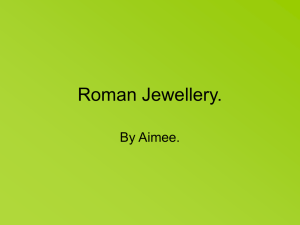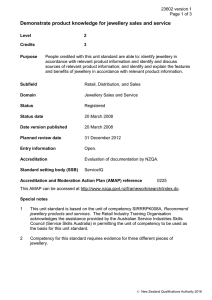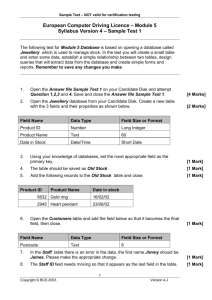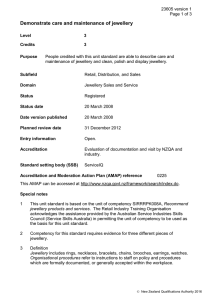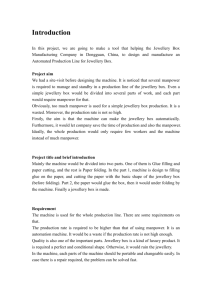Demonstrate technical knowledge of jewellery materials
advertisement
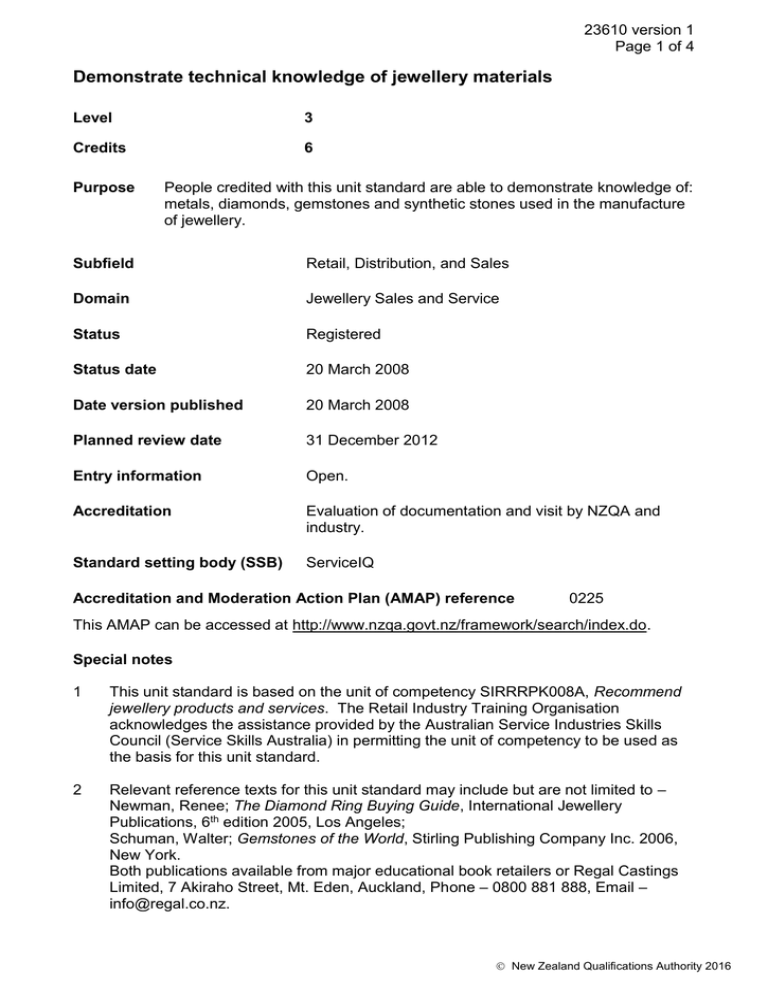
23610 version 1 Page 1 of 4 Demonstrate technical knowledge of jewellery materials Level 3 Credits 6 Purpose People credited with this unit standard are able to demonstrate knowledge of: metals, diamonds, gemstones and synthetic stones used in the manufacture of jewellery. Subfield Retail, Distribution, and Sales Domain Jewellery Sales and Service Status Registered Status date 20 March 2008 Date version published 20 March 2008 Planned review date 31 December 2012 Entry information Open. Accreditation Evaluation of documentation and visit by NZQA and industry. Standard setting body (SSB) ServiceIQ Accreditation and Moderation Action Plan (AMAP) reference 0225 This AMAP can be accessed at http://www.nzqa.govt.nz/framework/search/index.do. Special notes 1 This unit standard is based on the unit of competency SIRRRPK008A, Recommend jewellery products and services. The Retail Industry Training Organisation acknowledges the assistance provided by the Australian Service Industries Skills Council (Service Skills Australia) in permitting the unit of competency to be used as the basis for this unit standard. 2 Relevant reference texts for this unit standard may include but are not limited to – Newman, Renee; The Diamond Ring Buying Guide, International Jewellery Publications, 6th edition 2005, Los Angeles; Schuman, Walter; Gemstones of the World, Stirling Publishing Company Inc. 2006, New York. Both publications available from major educational book retailers or Regal Castings Limited, 7 Akiraho Street, Mt. Eden, Auckland, Phone – 0800 881 888, Email – info@regal.co.nz. New Zealand Qualifications Authority 2016 23610 version 1 Page 2 of 4 3 Legislation Knowledge of the following legislation applies – Consumer Guarantees Act 1993; Fair Trading Act 1986; Sale of Goods Act 1908; Layby Sales Act 1971; Credit Contracts and Consumer Finance Act 2003; Privacy Act 1993; and any regulations. 4 Definition Gemstone refers to naturally occurring minerals and rocks which have been formed without man’s intervention. Jewellery includes rings, necklaces, bracelets, chains, brooches, earrings, watches. Synthetic stone refers to crystallised or re-crystallised products whose manufacture, by whichever method, has been caused completely or partially by man. Their physical and chemical properties and/or their crystal structure essentially correspond to those of the natural stones which they imitate. Elements and performance criteria Element 1 Demonstrate knowledge of metals used in the manufacture of jewellery. Range may include but is not limited to – gold, silver, platinum, rhodium, palladium, titanium, copper, brass; evidence of six metals required. Performance criteria 1.1 Metals used in the manufacture of jewellery are identified in accordance with relevant reference texts. 1.2 Features of different metals used in the manufacture of jewellery are explained in accordance with relevant reference texts. Range features may include but are not limited to – malleability, durability, ductility, tensile strength, fusibility, resistance to oxidation, ease of assembly, cost; evidence of six features required for each metal. Element 2 Demonstrate knowledge of diamonds used in the manufacture of jewellery. Performance criteria 2.1 The characteristics of diamonds used in the manufacture of jewellery are explained in accordance with relevant reference texts. Range characteristics include but are not limited to – colour, brilliance, iridescence, hardness, blemishes, inclusion, shape, cost, country of origin, size. New Zealand Qualifications Authority 2016 23610 version 1 Page 3 of 4 2.2 Basic diamond grading criteria are explained in accordance with reference texts. Range colour, clarity, cut, carat. Element 3 Demonstrate knowledge of gemstones used in the manufacture of jewellery. Range gemstones may include but are not limited to – sapphire, emerald, amethyst, ruby, pearl, opal, aquamarine, quartz, garnet, topaz, tourmaline; evidence of six gemstones required. Performance criteria 3.1 Gemstones used in the manufacture of jewellery are identified and their properties explained in accordance with relevant reference texts. 3.2 The characteristics of different gemstones used in the manufacture of jewellery are explained in accordance with relevant reference texts. Range characteristics include but are not limited to – colour (hue, tone, saturation), size, cut, country of origin, shape, availability. Element 4 Demonstrate knowledge of synthetic stones used in the manufacture of jewellery. Range evidence of six synthetic stones required. Performance criteria 4.1 Synthetic stones used in the manufacture of jewellery are identified and their properties explained in accordance with relevant reference texts. 4.2 The characteristics of synthetic stones used in jewellery manufacture are explained in accordance with relevant reference texts. Range characteristics may include but are not limited to – colour (hue, tone, saturation), size, cut, country of origin, shape, availability. Please note Providers must be accredited by NZQA, or an inter-institutional body with delegated authority for quality assurance, before they can report credits from assessment against unit standards or deliver courses of study leading to that assessment. Industry Training Organisations must be accredited by NZQA before they can register credits from assessment against unit standards. New Zealand Qualifications Authority 2016 23610 version 1 Page 4 of 4 Accredited providers and Industry Training Organisations assessing against unit standards must engage with the moderation system that applies to those standards. Accreditation requirements and an outline of the moderation system that applies to this standard are outlined in the Accreditation and Moderation Action Plan (AMAP). The AMAP also includes useful information about special requirements for organisations wishing to develop education and training programmes, such as minimum qualifications for tutors and assessors, and special resource requirements. Comments on this unit standard Please contact the ServiceIQ qualifications@serviceiq.org.nz if you wish to suggest changes to the content of this unit standard. New Zealand Qualifications Authority 2016
